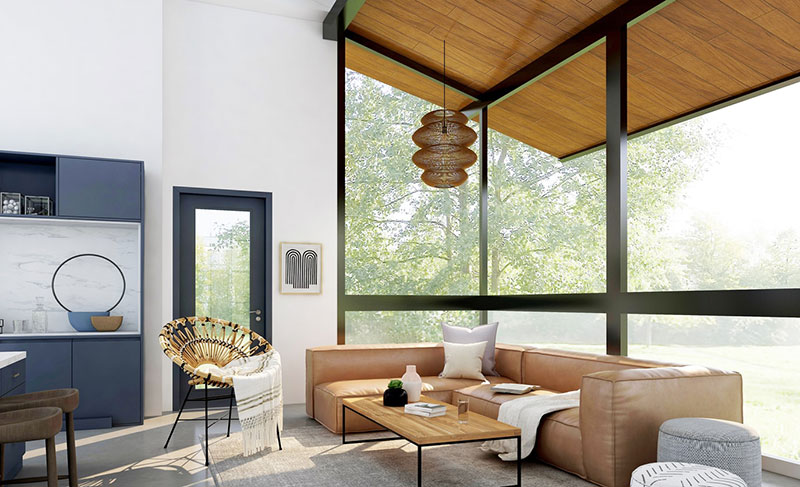Advertisement
How you design your home affects a lot more than what it looks like to guests and visitors. Everything from the colors you choose to your furnishings also impacts your mood and mental health.
For example, if you’re choosing a new paint color, some will affect your mood differently than others.
Of course, you want a space that will make you feel your best mentally and emotionally, and any time you can give yourself a mood boost, that’s a good thing.
With that in mind, the following are some of the more specific ways design affects your mood and mental health.
Color Choice and Mood
Colors influence our mood, possibly in more significant ways than we realize. There’s a reason that major corporations, for example, hire people to help them choose branding colors.
Some of the effects of colors that you might think about in your home include:
- Red is associated with power, love, and energy. However, if you go overboard with the red in your home, it can create feelings of anger or anxiety. When you use it moderately, it may help your space feel warm and inviting. Brighter shades of red tend to be seen more in contemporary styles, and deeper reds with brown undertones are often in more traditional designs.
- Orange is a color we associate with youthfulness and creativity. Workplaces will often incorporate orange in some form or another to stimulate conversation and innovation.
- Yellow is a color we associate with positive emotions like happiness.
- Green is a color that evokes nature, so it’s an excellent way to bring the outdoors inside. When we see green, we think of the outdoors and the warm weather months of spring and summer. Green is also a color that creates feelings of stability, and it can be soothing and calming.
- Blue has connotations of water, so it’s calming. Darker blue is more rich and dramatic, while light blue can be cheerful and upbeat.
- Purple is a color that creates feelings of creativity and also mystery.
- The color white is bright, calm, and soothing because it can make a space more light and open.
- Gray and similar neutral colors can be calming.
The Use of Space
When your home is designed to make use of available space and has areas for organization, it will help you feel more relaxed and balanced in other parts of your life.
Research shows that clutter makes us feel anxious.
In general, in home design, remember that less is more, but at the same time, you want balance. If you have vast areas of unused space, this can feel lonely. Minimalism in design doesn’t necessarily mean a space is empty. Minimalist designs tyles just use simple lines and color palettes, but the scale of the furnishings and items in a room is generally balanced.
Lighting
Lighting influences our mood in so many ways that we may not even notice. The importance of lighting is why people will use light boxes and lamps in the winter—it helps replicate natural light that they may get less of during cold weather months.
In your home, natural light will uplift you. Darkness, particularly when you should be exposed to bright natural light, can be depressing.
If you’re buying a new home or building one, you want to find a property with windows that let plenty of light shine in.
As you decorate, build your window coverings around the natural light. For example, you can dim the sun without blocking it out with translucent coverings.
You can also use artificial light to a mood-boosting advantage. For example, choose lighting with warm hues instead of bright or fluorescent light. You can also layer lighting using lamps and several different sources so that you can adjust it according to how you’re feeling and the activity you’re doing at any given time.
Feng Shui Principles
Feng Shui is an ancient philosophy that’s Chinese. The purpose of Feng Shui is to create harmony and peace among elements, including the elements in your home.
Those who practice Feng Shui believe that the right placement of your furnishings or objects in your home can create positive energy. When your home is designed in a way that evokes positive energy and lets flow, then you may have better health, wealth, happiness, and relationships.
Many of Feng Shui principles are relevant to general home design psychology.
For example, you should place furniture to see the doorway. According to Feng Shui, you should be able to see where you enter and leave a space.
You should use vertical space in a room by hanging things on the wall and bringing the eye upward.
You should minimize clutter and also think about adding plants. When you have living plants as part of your home décor, along with being good Feng Shui, it cleans the air and gives off oxygen.
Metallics are surprisingly part of Feng Shui. You should use metallic fixtures and accents such as copper when you get a chance.
Texture
Even in a home with a relatively simple or minimalist design concept, texture is a good way to add visual interest. Along with being good from a design sense, adding texture to a space makes it warmer and inviting. When you feel soft or comfortable textures, you’re going to feel cozier in a space.
Think about shag rugs or layered upholstery and pillows.
Overall, you also want the design of your home to reflect who you are and how you use the different spaces. Function is more important than form because if you aren’t happy with something in your home, it doesn’t matter how many design principles it adheres to. You want to reflect your best self and your aspirations within your home’s design.
When you can achieve these goals, your home is your oasis.

